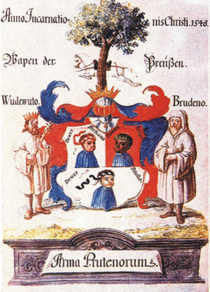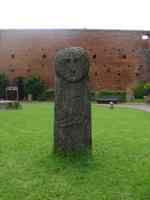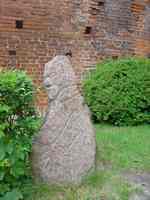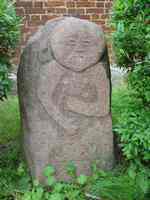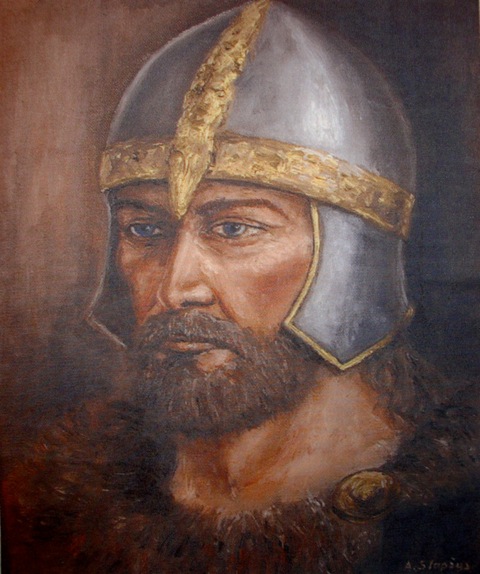
The history of ancient Prusai WHO WERE THE PRUSAI? ARCHEOLOGY COULD PRUSAI BE CHRISTIANS ? Mieszko I Poland THE ARMS AND THE WAY OF FIGHT THE CONQUEST, I, II UPRISING THE III-rd PRUSAI UPRISING The PRUSAI KNIGHTHOOD OPPOSITION What has happened to Prusai? THE GERMANIC ENSLAVEMENTS
The Battle of Grunwald
Culmland Banner The Prusai Maps
PRUSAI
Prusians Heroes Prominent Prusian Where you are, Prusai?
COAT OF ARMS
The Coat of Arms THE COAT OF ARMS PRUS I, II, III Unknown version Prus I,II, III Prus - name and Coat of Arms UNKNOWN COAT OF ARMS EUROPE MONARCHIES
PRUS DESCENDANTS
Pilewski
KURPII
The Kurppii Genesis
THE DISPUTE ABOUT HISTORY
German militarism Tadeusz Mrozinski
CULTURE
About the Prusai language The Prusai language and its sources ART AND PEOPLE Archeology Prusian Babas
PUBLICATIONS
Die Altpreußischen Personennamen Download
Elbling Dictionary
FORUM
FORUM - ARCHIVES
MAIL: PRUS@PRUSOWIE.PL
Counter
Counter
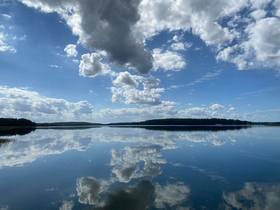
PRUSSIAN STONE STATUES
Prussian stone statues might represent:
1. commemoration of the famous warriors, magnates, heads of families. The tribes have not created the Prussian state organization ever. Prussian model tribal families, relied upon close connection of language, professing the faith, and similar rules established similar lifestyles. Commander in chief produced a system of well-armed warriors, gave the teams, a sense of independence and security.
Concentrated in families of tribal organization to adopt the common name, its own system of laws and norms of conduct and determine their own territory, which defended against outsiders. The area was not so precise limits and depend on economic activity and armed tribesmen.
The social structure of clans and tribes has been mixed. The families could differ the Prussians, but due to land properties in other places could also unite the Prussian.
2. gods, such as God Potrimkusa, Potrimpusa, Potripo - horn and sword would be the symbols of water, life and death.
Presented in the coat of arms of Prussia as a blackman, the flag of the runes being the youngest, and as one of the
monuments on the figure representing Romow
 |  |
Divine Trinity: Perkuns, Patollo and Potrimpus.. | |
Center of worship of deities of Prussia was the Romove. This place is supposedly founded by Brutenusa the Nadrowii. He was a brother of Widewuta and both were regarded as legendary founding fathers of the cult and the royal order in Prussia. (see the coat of Prussia).
In the middle of Romove stood the holy oak, where the statues were: Perkunsa, Patolla and Potrimpusa.

Perkun (Lithuanian Perkunas, Perkuns, Finnis Perkele, Latvian Perkonos, Perkons, Slavic Perun, Prussian Perkunis, probably derived from the core praindoeuropean perk-“oak”) - the supreme, sovereign deity pantheon of Balts, thunderbolt, the god of the heavens, fire and war. His holy symbol was an oak.
Patrimps, Potrimpus, Natrimpe the water god, the god of magic, master of life, fertility and death, the guardian priests, diviners, shamans - the god of wisdom. His was the personification of Patollus, Prussian god of death and destruction.
Without going into the question three of the gods in other religions of the heathen, I wonder whether this trinity was also important for the unity of the Prussian lands. (?)
Coat of Arms Prussians gem shows a horse and oak. It is known that these two symbols are important to the Prussians.
I wonder if the combination of horse and oak is a symbolic representation of union territories Witlandu (literally,
Land of forests) and Aestii - a combination of cultures and groups of Elbling and Sambian Dollkeim-Kovrovo.
If, as it turns out that this interpretation “of the Prussian statues of stone” would be somewhat approximate, is whether the term
"Old Prussian Woman" ("Baby Prussian") would not insult the Prussians?
>
 www.Prusowie.pl - polski
www.Prusowie.pl - polski